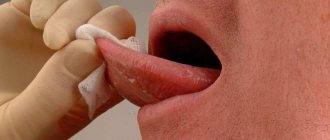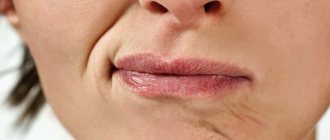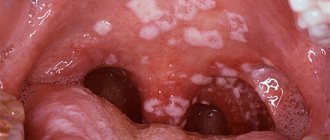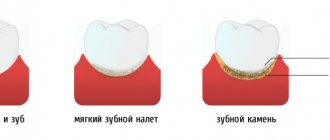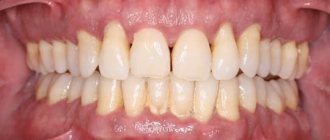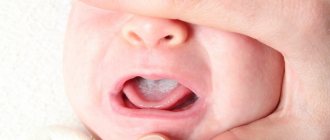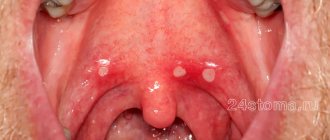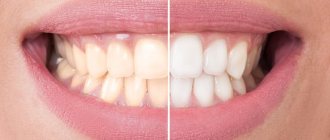How does cheilitis manifest itself on the lips and what forms of pathology are there?
Quite a lot of people are faced with the problem of dry lips and the appearance of crusts and cracks on them. But few people know that this kind of manifestation can be a symptom of a problem called cheilitis on the lips. This inflammation often occurs due to the influence of external negative factors, and some of its forms can provoke the development of serious complications. To protect your body from danger, it is worth learning in more detail about the causes of the disease and methods of combating it. And for this, read today's material.
Rash on lips in pregnant women
During pregnancy, certain prerequisites arise for the activation of the herpes virus. The body perceives the fetus as something foreign, and to prevent its rejection, maternal immunity is automatically reduced. The main symptom of the disease is a rash on the lips.
The disease can be primary or recurrent, the effect of the virus on the unborn baby depends on this. If a woman has previously had herpetic manifestations, the probability of danger to the fetus is estimated at approximately 5%. This is explained by the presence of specific antibodies in the blood. If the body has not previously been infected, the risk of fetal pathologies increases markedly.
But a rash on the lips of a pregnant woman is often a sign of hormonal changes in the body, especially in the early stages. The main reason is an increase in progesterone production. Such conditions are not dangerous for either the mother or the child.
Allergies also do not pose any risks to the fetus: the placenta provides reliable protection against allergens and antigens, as well as antibodies that are produced to suppress them. All these substances do not get inside the fertilized egg.
What is "cheilitis"
The name of the problem comes from the Greek word “choilos”, which translates as “lip”, so inflammation that affects the mucous layer, the red border and the adjacent skin is called cheilitis. In exceptional cases, unpleasant symptoms can affect not only the upper or lower lip, but also the oral cavity, surrounding areas of the epithelium, as well as the membranes lining them from the inside. Cheilitis is characterized by a long course and is often combined with stomatitis or dyskeratosis (abnormal thickening and roughening of the skin near the mouth).
Why does inflammation appear on the lips?
There are many varieties of cheilitis, which differ in their manifestations and are provoked by different reasons. Let's take a closer look at these factors.
What triggers the development of the disease
There is practically no protective layer on human lips, so they are highly susceptible to external factors. For this reason, people are often concerned about the drying out of the mucous membrane, which leads to the appearance of microcracks and further infection.
The most common causes of the problem are the following:
- changes in air temperature, sun, wind - these natural factors dry out the skin and it cracks,
The sun, wind, sudden changes in temperature can affect the condition of the lip mucosa - the use of low-quality lipstick or hygiene balms - the lanolin they contain can clog the pores with a secretion that does not allow the skin to breathe,
- dermatoses, allergic reactions - dangerous chemical compounds in contact with the surface of the epithelium cause rashes, cracks or wounds,
- the predominance in the diet of spicy, sour, salty or hot foods that irritate the epithelium and mucous membranes,
- congenital, acquired diseases of the thyroid gland, immunodeficiency states - these pathologies negatively affect the skin,
- skin tuberculosis, venereal infectious diseases, lichen,
- diseases of the central nervous system - because of them, patients may feel itching,
- chemotherapy,
- vitamin deficiency - a lack of nutrients in the body negatively affects the functioning of all its systems,
- mechanical damage.
If a child breathes through his mouth during sleep, his lips may become dry.
Sometimes pathology occurs in a child if he breathes through his mouth during sleep. However, if an adult has a chronic runny nose, he will also breathe through his mouth. With such a violation of the physiological state, the sensitive skin and oral mucosa dries out, then unpleasant defects appear.
Causes of red moles
The exact reason why red moles appear on the body is unknown; it may be a predisposition due to a genetic factor. But there are other reasons:
- pregnancy;
- exposure to chemicals;
- some diseases, including infectious ones;
- unsuitable climate (too hot or cold)
- mechanical damage to the skin, such as a bite or cuts, in which pieces of skin are not completely torn off.
Their manifestations are also possible at a more mature age, this is due to a gradual decrease in immunity. Neoplasms occur in 75% of the population over the age of 60 years.
It is impossible to somehow influence the appearance or non-appearance of red moles on the body, since they are inherent in us at the genetic level; if one of the parents had a lot of them, it means that the children will have a similar situation, and even identical maps of the location of nevi are possible.
Main signs of cheilitis
All manifestations of the inflammatory process have varying degrees of severity, but the following symptoms are mainly noted:
- dry skin around the mouth,
- cracking, appearance of small wounds,
- bleeding at the site of damage to the integrity of the epithelium,
- redness and swelling of the red border,
- loss of elasticity of the epithelium, appearance of a keratinized layer,
- pain in the area of inflammation,
- the occurrence of painful sensations caused by mechanical irritation of erosive areas during chewing food,
- change in color of the affected areas of the mucous membrane.
Cracks and wounds indicate a problem.
If even one of the symptoms described above appears, it would be a good idea to see a doctor. The sooner a pathological condition can be recognized, the faster it can be eliminated.
Are red moles dangerous?
Signs to pay attention to if small red moles appear:
- Color. If it is uneven and begins to change, this is a reason to visit a doctor.
- Inflammation around the formation, that is, redness in the form of a halo around the mole.
- An increase in the size of the mole or its thickening.
- The appearance of cracks and ulcers on the body of the mole.
- Hair loss if it grew from a mole.
- The appearance of itching, burning or tingling in the place where the mole is located.
- A change in the edges of the nevus also indicates that it is time to visit a specialist.
An accurate diagnosis can be made by a dermatologist or oncologist, and you can and should turn to them for help. Nevi are not dangerous as long as they are in a stable condition, in which case you can wait to see a doctor.
Types of disease
Cheilitis is a fairly large group of diseases that vary in their clinical manifestations and origin. For example, with absolutely similar symptoms, sometimes different reasons for the development of the problem are identified. In this regard, treatment methods also differ - medications of various effects are prescribed for oral administration, ointments, creams or physiotherapy.
Important! Cheilitis can be an independent type of disease or accompanying with more serious pathologies. Treatment cannot be delayed, because due to frequent damage to the epithelium, the risk of developing malignant tumors increases.
This disease must be correctly classified in order to determine how and with what to treat it. Accordingly, you should not engage in self-diagnosis; it is better to go to a doctor to clarify the cause. All types of cheilitis encountered in practice can be divided into two large categories: independent and symptomatic. The former arise as a reaction of the body to certain phenomena, the latter – as a symptom of the underlying disease. Cheilitis is also divided according to the nature of its manifestations and the nature of its origin. Next, we will consider these classifications in more detail.
Red moles in children
For most people, the bulk of moles appear in the first 20 years of life, then the formation of moles (nevi) subsides. They also tend to sometimes disappear on their own, and this happens due to the fact that the blood vessels supplying the mole dry out or become clogged. One in 100 newborns are already born with small red moles on their body, and they are considered more prone to change and develop into melanoma. This red neoplasm that rises slightly above the surface of the skin is called a Spitz nevus.
Children can also be born with large blue spots on their backs; they are called Mongolian spots and are most often found in children with Asian roots. Any moles are often injured, especially in childhood. This can cause complications, so it is advisable to sometimes see a doctor, and also try to protect children from such injuries.
Division by nature of manifestations
In medical practice, there are many different forms of the pathology in question, many of which are graded according to the characteristics of their pathological manifestations. The most common cases are described below.
Angular form
This type of pathology is also popularly called “jamming.” Depending on the pathogen, angulitis can be candidal (infection of the epithelium by fungi of the genus Candida) or streptococcal (inflammation caused by streptococci). Develops with vitamin deficiency, in the presence of HIV infection, diabetes, and caries in the body. Also, provoking factors can be the habit of biting nails, soaking the epithelium due to frequent licking.
Angular form
Catarrhal form
One of the most common forms, as it occurs as a result of mechanical damage, abrasions, scratches and bacterial infection. Its appearance is also provoked by frequent wetting of the red border with salivary fluid, as well as exposure to excessively hot, humid or dry air. The problem manifests itself as hyperemia and severe swelling. In some cases, slight peeling of the epithelium is observed. The phenomenon can be either infectious or non-infectious in nature.
Catarrhal form
Eczematous form
The disease usually occurs due to the body's reaction to allergens (food, cosmetics, medicines, materials used in dentistry for prosthetics or filling teeth). Its main difference is the patient’s history of eczema. In the acute stage, the disease leads to the formation of scales and crusts on the lips, as well as their severe swelling. Patients usually complain of itching and burning. Often the lesion affects areas adjacent to the red border.
Eczematous form
Exfoliative form of cheilitis
Exfoliative cheilitis is more common as a chronic problem affecting the middle of the lips, where the vertical fold is located. It can be triggered by a lack of vitamin B2, decreased immunity, malfunction of the thyroid gland, and mental disorders. Bad habits (smoking or lip biting) are also often triggers. However, the main cause of the problem is considered to be a psycho-emotional disorder - depression, severe emotional shock, constant stress. The inflammatory process affects the red border, scales appear, tightly fused to the underlying tissue. Patients complain of dry epithelium and burning sensation.
Exfoliative form
Granulomatous form (Mischer cheilitis)
This is a lesion of the mucous membrane, which is characterized by severe swelling of the lips. Often the lower part of the skin-muscular fold “suffers” the most. This swelling becomes smaller during one period, but later increases again. In addition, the development of the pathological process is accompanied by the formation of tiny granulomas in the thickness of the soft tissues - it is because of this that the tissues thicken. The etiology of the development of this phenomenon has not been established. There are suggestions that the problem is based on disturbances in the functioning of blood vessels and nerve fibers, as well as infectious infection. However, these are only hypotheses that do not yet have proven facts.
Misher cheilitis
Division by nature of origin
Now let's look at the classification of cheilitis based on the nature of its origin. The following types of pathology are based on specific causes.
Meteorological (actinic) cheilitis
It begins to appear due to the adverse effects of weather conditions (humidity or dryness of air, sharp fluctuations in temperature, wind, etc.). With this form, pathological changes are not observed in the areas around the mouth and mucous membranes. Erosion and cracks appear if a person constantly licks his lips.
Frequent lip licking will lead to meteorological cheilitis
There is also actinic cheilitis, which is often confused with meteorological lip disease. In fact, it can be classified as a subspecies of the form in question. In this case, the pathology affects people who are sensitive to ultraviolet radiation. Most often, inflammation affects the lower lip, because it is more exposed to sunlight.
Candidiasis form
The culprits in the appearance of the candidiasis form of pathology are yeast-like fungi of the genus Candida. They actively begin to multiply against the background of decreased immunity, exacerbation of chronic diseases, taking antibiotics, or due to viral infections entering the body. Candidal cheilitis is localized even on the tongue, palatine arches and the inner surface of the cheeks. Because of it, a whitish-gray film or a light, cheesy coating often appears, under which a reddened and bleeding mucous membrane is hidden.
Candidiasis form
Atopic (contact allergic) form
It is a consequence of the body's allergic reaction to irritants. The atopic type of cheilitis usually becomes a symptom of atopic dermatitis or neurodermatitis; the lesion is not localized to the mucous membranes of the mouth and most often occurs in children, and under the age of 7-10 years. To a large extent, this form of allergic cheilitis is due to the influence of the environment and a person’s genetic predisposition to allergies. But the pathological process can be “triggered” by disorders in the functioning of the central nervous system, pathologies of the endocrine system, stress, excessive physical activity, disruption of the intestinal microflora and diseases of the ENT organs.
Atopic (contact allergic) form
The contact-allergic subtype of the disease manifests itself in the form of a delayed allergic reaction after the red border comes into contact with cosmetics or hygiene products (toothpastes, lipsticks), plastics included in dentures and other products that were previously used by an infected person.
Glandular form
This type of inflammation occurs when there are problems with the glands that secrete saliva. The pathology will be characterized by constant salivation and dilation of the ducts. The cause of the problem can be either congenital or acquired hyperfunction and hyperplasia of the salivary glands in the red border area. In this case, there is an almost continuous secretion of salivary fluid, which is why the lips remain wet most of the time, but when they dry out, they begin to crack and peel severely. Sometimes patients complain of itching and keratinization of the epithelium. A distinctive feature of this form of pathology is the formation of red dots.
Glandular form
Hypovitaminosis form
The impetus for the development of the problem is the lack of B vitamins in the body for a long time. Its characteristic feature is that simultaneously with damage, glossitis often occurs - swelling of the tongue. It takes on a bright crimson hue and becomes smooth. Also, teeth marks are imprinted on this organ. The red border begins to peel off and turn red, vertical cracks appear on the lips, which may cause bleeding.
Hypovitaminosis form
Heilith Manganotti
One of the main reasons for the development of pathology is considered to be the aging of the body - against the background of this natural process, immune defense decreases and the functioning of internal organs is disrupted, and saliva secretion decreases. Because of this, bleeding sores and ulcers can often be seen on the lips of older people.
Heilith Manganotti
Lupus cheilitis
The form represents one of the manifestations of systemic lupus erythematosus, which is at its peak of activity. The pathological process develops due to stagnation of excess blood in the vascular system of the lips.
Methods for diagnosing the problem
Many people facing the above problems do not know which doctor can help them. Therefore, experts remind that treatment for cheilitis should only be prescribed by a dentist, who, if necessary, can refer the patient to the office of an endocrinologist, dermatologist, immunologist, therapist or allergist. Doctors carry out the following manipulations: carry out a visual inspection of the affected areas, analyze the patient’s complaints and the totality of manifestations, study the results of blood tests (biochemical, general). In some cases, the affected tissues are subjected to histological examination.
Only a specialist can diagnose the problem and prescribe treatment
Diagnostics
In medicine, there is a general method for diagnosing skin tumors. These include an initial examination and recording of all patient complaints (history). If a malignant tumor is suspected, an MRI or radiography is prescribed. All data obtained is analyzed and conclusions are drawn, on the basis of which a preliminary diagnosis is made. The main and final point in making a diagnosis is the histological method (biopsy). It is a microscopic sampling of tissue from the body of a mole, and is done to identify the pathology of cells in the neoplasm.
General treatment recommendations
After determining the exact form of the disease, the doctor must assess its severity and how to cure it. If the problem is not severe and protracted, then it is effective to apply local correction of the endocrine glands using physiotherapy. The following activities are most often prescribed:
- laser therapy,
- ultrasound therapy,
- UV radiation,
- electrophoresis,
- blood transfusion.
In some cases, laser therapy is prescribed.
It is worth noting that in difficult cases, more radical treatment options are prescribed - electrocoagulation, laser ablation, surgical enucleation.
Do red moles need to be removed?
Not only is it possible, but it is also necessary. If the hemangioma increases in size, changes shape or color, this is, of course, a direct indication to see an oncologist as soon as possible for further examination, and removal if necessary. Of course, not using artisanal or folk methods, but with the help of modern specialists. If the mole behaves quite calmly and does not change shape or color, then most likely there is no need to be afraid and you can postpone removing the moles.
Drugs for drug treatment
You can get rid of itching and other uncomfortable symptoms with the help of drug therapy. In such situations, the following drugs are usually prescribed:
- antifungal agents (or antibacterial) taking into account the type of pathogen,
- antihistamines (to get rid of allergic manifestations),
- psychotropic and sedative against cheilitis of a neurological nature,
- vitamin complexes, immunoboosting agents,
- glucocorticosteroids for severe inflammatory processes,
- antiseptics and softening gels or ointments for treating wounds.
Do not start taking medications without first consulting a specialist. All funds are selected on a strictly individual basis.
Traditional medicine
To speed up the healing process, therapy with well-proven folk remedies is allowed. So, at home, anti-inflammatory, wound-healing decoctions and infusions are often used:
- aloe juice - peeled lower leaves of the plant are crushed, and the liquid from them is mixed with boiled vegetable oil in a ratio of 1:3. The resulting thick mixture is used to treat the affected areas at least 3-4 times a day,
Aloe juice is good for treatment - boiled sage or calendula - 2-3 tbsp. l. dry plants, pour 500 ml of water and boil for about 10 minutes. The mixture is filtered and applied to the affected areas every 30 minutes,
- oak bark - 40 g of crushed bark is poured into 200 ml of chilled water and kept for 30 minutes over low heat. The lips are lubricated every few hours with cooled and strained liquid.
“I once had meteorological cheilitis. I got rid of it very easily and quickly by regularly lubricating my lips with regular vegetable oil. It moisturizes the skin well and relieves the feeling of tightness.”
Yana S., 34 years old, Volgograd
The use of any traditional medicine recipes must be agreed upon with the attending physician. Otherwise, self-treatment can only aggravate the situation and lead to undesirable consequences.
Possible complications of the disease
Many people perceive the disease as a cold, and then do not pay due attention to symptomatic treatment. No one thinks about how to cure it, and in the meantime, without timely treatment, the problem develops into severe stages. The most dangerous complications are:
- development of malignant processes,
- the appearance of superinfections - the attachment of other strains of viruses to the affected cells.
Complicated forms of pathology can make it difficult to eat and even worsen the general condition of the body (provoke dizziness and weakness). Speech defects also occur, because crusts impede lip mobility. And pronounced aesthetic defects on the face often become the cause of psychological problems.
Locations
An increase in the growth of moles is observed in people aged 0 to 20 years, and then from 45 years and older. The rest of the time they appear, but not as actively as in the first and last phases of life. Typically, red moles appear on the upper body, arms, legs and shoulders. Their favorite places are also the head, feet, and hands. They can be located throughout the body, and it is impossible to predict their subsequent locations. Their red color comes from the accumulation of small blood vessels at the base, which supply them with blood.
Prevention of the disease
The following preventive measures will help to avoid the problem and prevent its progression:
- frequent, regular moisturizing of lips with hypoallergenic products containing natural ingredients,
- correct diet - excluding unhealthy foods from the menu, switching to a dairy-vegetable diet,
- avoiding contact with allergens,
- oral hygiene and timely visits to the dentist,
- taking multivitamins,
- regular exercises to strengthen the muscles of the cheeks and lips,
- giving up addictions (drinking alcohol and tobacco products).
Hypoallergenic hygiene products are perfect for prevention.
The main condition for a speedy recovery is a timely visit to doctors and implementation of therapy under their supervision. There is no need to take risks and self-medicate or use some folk method without additional medications, since the problem can become dangerous and the recovery process will drag on for a long period.
